Clinical |
Non-clinical |
 |
 |
Prof. WONG Man-yeung, Ronald
(ORCID) |
Prof. CHEUNG Wing-hoi, Louis
(ORCID) |
 |
 |
Prof. LAW Sheung-wai |
Prof. WANG Huating
(ORCID) |
 |
 |
Dr. TANG Ning |
Prof. ZHANG Ning
(ORCID) |
 |
|
Prof. LEUNG Kwok-sui |
Children Bone Health and Musculoskeletal Disorders During Growth
Clinical Research
Adolescent idiopathic scoliosis (AIS) is a prevalent three-dimensional spinal deformity mainly affecting adolescents during growth. Our research team is internationally recognized for defining the association between low bone mineral density (BMD) and AIS. We found that low bone mass was an important prognostic factor for curve progression to the surgical threshold and it does persist across maturity in AIS girls. In addition, we investigated bone qualities with advanced in vivo imaging and micro-imaging technologies including dual energy x-ray absorptiometry, quantitative ultrasound, quantitative computed tomography (QCT) as well as high resolution pQCT (HR-pQCT or XtremeCT). All these have significantly contributed to our understanding of the etiopathogenesis of AIS.
1) Anthropometric, Skeletal Growth and Bone Mineral Study in AIS Girls
| • |
Anthropometric analysis of AIS girls during peri-pubertal rapid growth period |
| • |
Systemic low bone mass and poor bone mechanical properties in AIS |
| • |
Prognostication of bone mineral status for curve progression in AIS |
| • |
Long-term follow up of bone mineral status in AIS girls |
| • |
Bone qualities in AIS in terms of gross morphology, volumetric bone mineral density and trabecular bone micro-architecture |
| • |
Lifestyle factors affecting the bone mineral status in AIS |
| • |
Muscle mass and bone qualities in AIS |
2) Whole-body Sagittal Alignment
In spine surgery, it is necessary to understand the age- and gender-related reference values of whole-body sagittal alignment with the use of EOS imaging system, which serve as an important reference for spine surgeons planning deformity correction. The prevalence of adult spinal deformity (ASD) has been reported to be as high as 60 % in the elderly population. Sagittal alignment among patients with ASD plays a critical role in pain and disability, and a primary determinant on the health-related quality of life assessment. In age-related decompensated sagittal balance, the trunk often shows increased forward leaning, retroverted pelvis, extended hip and flexed knee, which suggest the activation of adaptive whole-body compensatory mechanism to maintain an economic balanced erect posture.
3) Neuro-anatomy, Otoneurology and Radiological Advanced Computational Imaging Studies for AIS
| • |
Morphometric analysis of spine, skull |
| • |
Spinal cord morphometry |
| • |
Cerebellar tonsillar level |
| • |
Brain morphometry and cerebrum and cerebellum |
| • |
Vestibular system morphology |
| • |
Biomechanical modeling of spinal growth in AIS |
| • |
Neuro-conductivity by Somatosensory Evoked Potential |
| • |
Posture balance assessment |
| • |
Deep learning for automatic Cobb angle measurement in both sagittal and coronal plane |
4) Non-ionizing Radiation Ultrasound Assessment
| • |
Automatic ultrasound Cobb angle measurement compared with EOS X-ray system |
| • |
Feasibility of ultrasound for longitudinal curve severity monitoring |
| • |
Early diagnosis and screening by ultrasound Cobb angle measurement |
5) Health-related Quality of Life (HR-QOL) Studies in AIS
HR-QOL is an important consideration when treating AIS both with braces and with surgery. Our centre is equipped with a web-based platform for self-administration of the AIS HR-QOL questionnaire, SRS-22 and SAQ, before and after operative procedures to monitor any changes in HR-QOL with surgery. HR-QOL designed for various domains of health are translated and subjected to validity and reliability testing. They relate to more specific domains which are of particular relevance when spinal appearance or other aspects of quality of life are being considered.
Basic Research
1) Vitamin D Insufficiency in Adolescents
Adolescence is the critical period for bone mineral accretion and deserves our attention and focus as an important area for research. We are active throughout these years in carrying out researches on children bone health, calcium absorption and calcium dietary supplementation for children. Our recent studies were evaluating the Vit-D status and knowledge on Vit-D among adolescents in Hong Kong. We noted gross deficiency in knowledge on Vit-D among our adolescents and a high prevalence of Vit-D insufficiency and its association with bone parameters which are physiologic surrogates for bone health status. These will be followed by further in-depth studies into Vit-D physiology and preventive measures and therapeutic intervention for Vit-D insufficiency for the young population.
Image adopted from Cheung et al., Osteoporosis International, 2016.
2) Bone Qualities in Normal Adolescents During Pubertal Growth
By HR-pQCT, we found that, after adjustment of age, bone area, lifestyle parameters, there is a transient phase of higher porosity at distal radius due to longer delay in trabecular bone formation and coalescence may contribute to lower bone mechanical properties and higher distal radial bone fragility in Chinese boys than girls.
Adjusted mean of porosity of total cortex and bone mechanical property at distal radius of boys (solid line) and girls (dotted line) by Tanner stage. *: p<0.05 in sex difference at that Tanner stage by ANCOVA.
Result adopted from Cheuk et al., Journal of Bone and Mineral Research, 2018.
3) Genome-Wide Association Study and Heritability of AIS
AIS is regarded as a multi-factorial disorder with significant genetic predisposition. Genetic association study is therefore one of the principal approaches in etiology studies in AIS.
Like many common diseases such as diabetes mellitus, myocardial infarction and cancers, a proportion of AIS appears to run in families. Through a familial study in AIS, we reported the overall heritability of AIS was estimated to be 87.5±11.1%.
4) Bone Cell Morphometric and Functional Analysis
Systemic osteopenia, defined as Z-score of BMD ≤ -1 with reference to age and gender-matched controls, was found in over 30% of AIS patients. Our clinical findings have shown that osteopenia in AIS is an important prognostic factor for curve progression. These abnormal profiles in bone density and quality are associated with a number of genetic and endocrine factors. We have previously identified that low bone mineral density in AIS was partially attributed to aberrant melatonin receptor 1B and soluble leptin receptor. Recently, our research focus is on the roles and interactions of osteocytes, osteoblasts and osteoclasts in osteopenic AIS. We examined osteocytes in AIS biopsies Vs control with state-of-art techniques, and investigate the cellular functions and genetic profiles of primary osteoblasts and osteoclasts.
Service
1) School Screening Program for AIS in Hong Kong
Program conducted by Department of Health since 1995, our center is one of the two quaternary referral centers for treating scoliosis in Hong Kong. The prevalence of scoliosis in Hong Kong is about 2.8%.
Adopted from Luk et al., Spine, 2010.
2) Multimedia Scoliosis Clinical Management System
A web-based Multimedia Scoliosis Clinical Management System has been developed to meet the need of handling 800 new referrals annually from screening program. More than 17,000 patient records are now recorded in the system which supports concomitant access of 100 users from various workstations linked to the network in different locations within the hospital.
3) Bracing Treatment
We are active in providing bracing treatment for our patients including application of CAD CAM system in brace manufacturing and fitting; 3D ultrasound monitoring of brace fitting; temperature sensor to monitor the bracing compliance; and mindfulness program. The Brace Clinic is recently established for cross-disciplinary collaborative clinical research related to braces and other non-operative treatment for AIS.
4) Surgical Treatment
Major surgery for curve correction and instrumentation in severe scoliosis patients are performed in our center. Related research on instrumentation techniques, fusion strategy, SSEP monitoring and treatment outcome are actively being carried out. We went through various stages of development in surgical strategies and instrumentation from the posterior Harrington rod, ISOLA system, CD to the latest third and fourth generation posterior pedicle screw system and anterior surgery from Zielke instrumentation, Halms-Zielke system to the recent VATS procedures (video assisted thoracoscopic surgery). Our centre also pioneered the field of computer assisted surgical modelling and navigation surgery in improving the accuracy and safety of multiple pedicle screw application in major scoliosis corrections.
5) Health Promotion (Educational Talks, Exhibition Booth and Pamphlet)
Educational talks related to vitamin D and bone health were conducted in many primary and secondary school to increase the awareness on Vit-D and bone health through knowledge transfer and promoting healthy lifestyles to optimize Vit-D and bone health status through behavioral modification. Up to the end of 2017, more than 80,000 students, scoliotic patients and their parents have listened to our talks or video. We set up a booth to promote bone health through mini game in "Healthy Lifestyle Festival" funfair organized by The Boys' & Girls' Clubs Association of Hong Kong on 20 May 2017.
6) Web-based Bone Health Educational Platform
It is called "健骼知多D" (http://bonehealth.ort.cuhk.edu.hk) available both in English and Chinese. It was launched available for public viewing in May-2016. The interactive website has attracted more than 6,500 visiting count.
7) Mobile Application in Both Android and iOS System
It is available for free public download in Jun-2016 with narration in both English and Chinese languages on resource videos. About 600 downloads of mobile application was recorded.
Android version: https://play.google.com/store/apps/details?id=com.cuhk.vdp&hl=zh-TW
iOS version: https://itunes.apple.com/WebObjects/MZStore.woa/wa/viewSoftware?id=1153485574
Musculoskeletal Aging Research
Research interests
Research directions of our research team are driven by our careful observations from our clinical practice. Through research, we strive to understand the cause of the problems from many different perspectives, attempt to acquire new knowledge and learn new technologies within our reach to solve the problems, apply what we have learned to improve the ways to treat our patients in the clinic or the operating theatre, and ultimately try to prevent the problems in the community.
Sarcopenia Research
Sarcopenia is an age-related systemic syndrome with a progressive loss of skeletal muscle mass and muscle force combined with poor physical performance. In Hong Kong, approximately 40% of individuals aged 65 and above are affected by sarcopenia.
For basic research, our research team utilizes the SAMP8 and C57BL/6 animal models to investigate the changes in functional outcomes of muscle, muscle fiber cross-sectional area, and myofiber type and various treatment effects. According to our report (Wong et al, Osteoporosis International, 2019, 30(3), pp. 541–553), sarcopenia is a major risk factor for osteoporotic fracture. Our mission is to utilize accelerated or normal ageing animal models to investigate the pathology of the disease, including denervation, intramuscular fat infiltration (myosteatosis), mitochondrial dysfunction, gut microbiota dysbiosis, and more.
Clinically, our team developed a bioelectrical impedance analysis (BIA) model to predict appendicular skeletal muscle mass index (ASMI) as measured by dual energy X ray absorptiometry (DXA), and also reported the optimal body composition to prevent sarcopenic obesity. We used HR-pQCT to analyze the intramuscular fat, and single-fiber electromyography (SFEMG) to detect the neuromuscular function. Various clinical trials and AI-based studies are currently conducted by our team.
Our ultimate goal is to deepen the understanding of sarcopenia and develop effective strategies to mitigate its impact, thereby reducing the incidence of falls and fractures among the aging population.
Osteoporotic Fracture Healing
Osteoporotic or fragility fracture is a global health problem due to the escalating ageing population. In individuals with osteoporosis, the fracture healing process is often impaired and delayed, with an increased risk of complications such as fracture-related infections (FRI). Our research focuses on understanding the mechanisms underlying impaired fracture healing in osteoporotic bone and identifying strategies to enhance recovery. Our comprehensive program includes pre-clinical models of various osteoporotic fracture types and novel therapies to prevent and treat FRI, as well as clinical projects exploring interventions such as weight-bearing management to optimize treatment and rehabilitation outcomes following osteoporotic fractures.
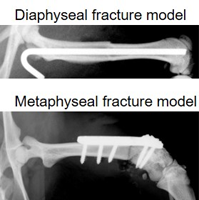 Fig.1 Osteoporotic fracture rat models at the diaphyseal and metaphyseal region for mechanistic studies. 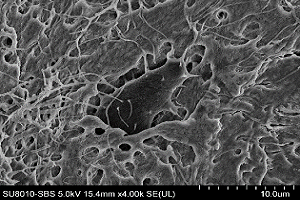 Fig.2 Morphological deterioration of osteocytes and their network in osteoporotic bone may play an important role in impaired fracture healing.  Fig.3 The design of liposomal Vancomycin/Vancomycin and DNase I loaded PLGA-PEG-PLGA hydrogel.  Fig.4 Bacterial biofilm stained with LIVE/DEAD, combined treatment of DNase I and Vancomycin showed biofilm dispersing and bacterial killing effect.
Biophysical Intervention
As the ageing population in Hong Kong continues to grow, the aim of utilizing a non-pharmaceutical biophysical intervention is to reintroduce weight-bearing exercise to physically inactive seniors. This approach seeks to reduce the risk of falls that could lead to fractures, and to accelerate the healing process if a fracture does occur.
 Fig.1 Self-developed and patented technology in Low Magnitude High Frequency Vibration Therapy (LMHFV).  Fig.2 Laboratory application of LMHFV platform.
Translational Research
Our randomized controlled trial demonstrates that an 18-month treatment with Low Magnitude High Frequency Vibration Therapy (LMHFV) can significantly reduce the fall rate among community-dwelling older adults. Another clinical trial suggests that a short duration of LMHFV during in-patient stay can improve clinical outcomes and may be effectively incorporated as a practical measure in the recovery of fragility hip fractures.
 Fig.1 Research subject receiving LMHFV treatment in a elderly community center.  Fig.2 CT scan images showing fracture healing at week 6 after treatment in a subject from (A) LMHFV group showing 80 % of osseous union and (B) placebo group showing 35 % of osseous union.  Fig.3 Patent related to the method to produce and transmit the vibration treatment was granted, successfully licensed and commercialized for application in the over 300 community centres in Hong Kong. Its impact has been proven beyond academia!
Personalized Orthopaedics Prosthesis and Implants
Personalized Orthopaedics Prostheses and Implants represent one of the most significant breakthroughs in orthopaedics and traumatology. They can be tailored using data from a patient’s skeletal contour. Personalised orthopaedic prostheses and implants developed during the preoperative planning procedure can facilitate smooth and accurate intraoperative execution.
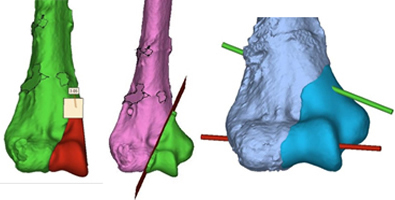 Fig.1 Personalised prosthesis for pelvic fracture.  Fig.2 Personalised prosthesis for acetabular fracture. 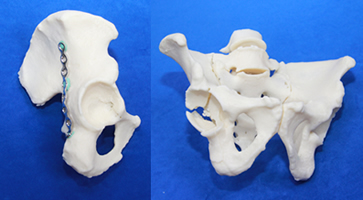 Fig.3 Personalised implant for pelvic fracture. 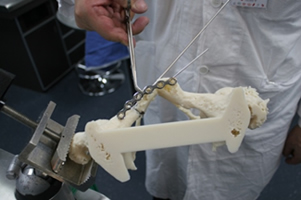 Fig.4 Personalised implant for acetabular fracture.
Personalized Surgical Instrument
Implementation of personalized surgical instrument in orthopaedic surgeries, supported by a thorough preoperative analysis of fracture configuration, deformity and pathology, as well as an assessment of the surgical approach and trial reduction or osteotomy, will enhance precise intraoperative execution and lead to satisfactory clinical outcome. Since 2013, folllowing the establishment of the Computer Aided Surgical Modeling Laboratory (CASMLab), we have been providing computer aided surgical planning and modeling services.
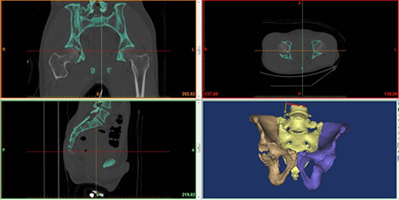 Fig.1 Preoperative analysis. 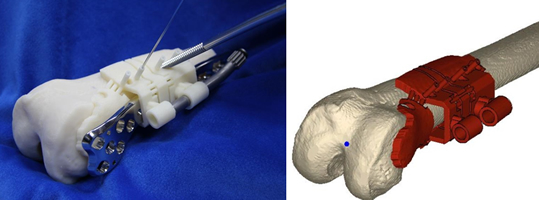 Fig.2 Personalised surgical instrument for corrective osteotomy.  Fig.3 Personalised surgical instrument for femoral fracture.  Fig.4 Personalised surgical instruments and bone models. 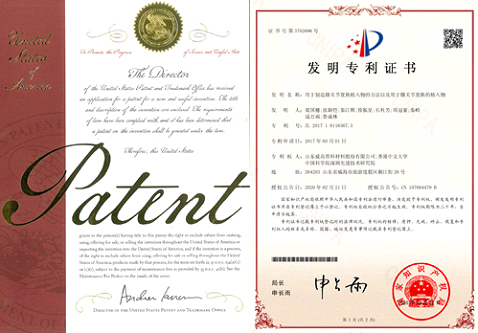 Fig.5 Patent granted for the invention of a method to manufacturing of personalized prosthesis using computer aided strategies.
Robotic Arm Assisted Surgery
Implementation of surgical robot with enhanced precision, rigidity and stability can minimize intraoperative errors and help avoid unnecessary surgical accidents. We are actively involved in the research and development of surgical robot systems. To date, we have developed two generations of surgical robots and successfully completed over 50 robot assisted clinical cases.
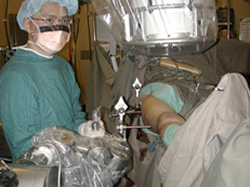 Fig.1 The 1st generation of our developed robot.
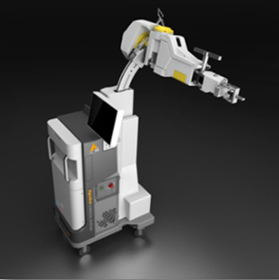 Fig.3 Surgical robot with passive-active design.  Fig.2 The 2nd generation of our developed robot.
Community Fall Prevention Campaign
http://www.no-fall.hk
Primary prevention of fragility fracture is the next major challenge facing our ageing society. The most effective way to reduce fractures is to reduce the risk of those most prone to falls. We have over a decade of experience in educating older people and community workers on how to reduce fall risks. Collaborating with the community is an essential part of our knowledge transfer efforts.
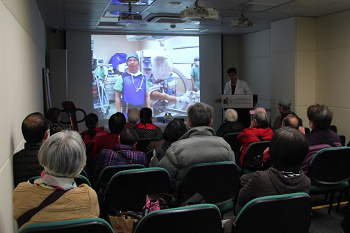 Fig.1 Fall prevention talk to participating elderly volunteers.  Fig.2 Workshop on home-based muscle strengthening exercise delivered to fragility fracture patients and their carer.  Fig.3 Elastic-band exercise is an effective home-based resistance exercise for the primary prevention of sarcopenia and fall-related fractures. 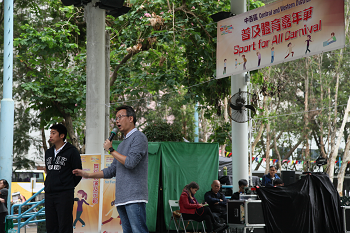 Fig.4 Fall prevention talk in the community with specific focus on home risks, diet recommendations and physical activities.  Fig.5 Community older people participating at elastic-band exercise workshop delivered by the fall prevention team. 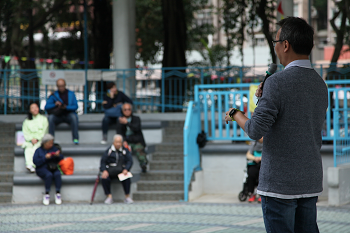 Fig.6 Fall prevention talk in the community with specific focus on home risks, diet recommendations and physical activities. |